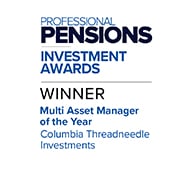CT Dynamic Real Return Fund




Reasons to invest
Dynamic asset allocation
The Fund is able to take advantage of opportunities as they present themselves, thanks to its unconstrained asset allocation approach.
Volatility controlled
Holistic risk awareness with a focus on preserving and growing capital over the medium to long term.
Active underlying investments
The Fund exploits active return sources at both the asset allocation and stock selection levels.
Straightforward
Long only, unlevered investment approach across broad asset classes – equities, fixed income, commodities, property, cash and absolute return strategies.
Heritage in asset allocation
Columbia Threadneedle Investments has a proven, long-term investment process that harnesses the expertise of our global investment platform.
Investment Approach
We seek to achieve the strategy’s performance objective by dynamically changing the portfolio risk budget; we are able to select from regional equity, fixed income, property and commodity market exposure where appropriate, but, importantly, the portfolio can also be zero-weighted in any asset class. There is no ‘neutral’ allocation, so every investment position is a risk position. The typical average holding period is 12-18 months, although the actual holding period can vary depending on our investment outlook.
The Asset Allocation Strategy Group uses the output from three proprietary research groups to formulate its macroeconomic and thematic views, and defines the investment environment used to build asset allocation portfolios. This is combined with a valuation framework across all asset classes, and is used by the group to determine its preferred asset allocation and risk preferences. We manage this strategy using a threestage approach, which is outlined in the chart below:

Key Facts
Target | CPI+4% | Volatility | Up to two-thirds of equity volatility |
|---|---|---|---|
Neutral Allocation | Unconstrained – no neutral positions | Launch Date | June 2013 |
Asset Allocation Limits | Equity 0-75% Cash & Bonds 0-100% Commodities 0-20% Alternatives 0-10% Property 0-20% | Implementation | Passive strategies Physical securities Internal Funds |
Sources of Return | Majority through asset allocation Additional through stock selection (smaller proportion) | Lead Portfolio Manager | Christopher Mahon |
Structure | NURS | Leverage | Long only, unlevered |
Liquidity | Daily | Ongoing Charges Figures (OCF) | 50 bps |
Insights
Is the worst of the trade war already behind us?
How much uncertainty can markets stomach?
Tariff turmoil, German rearmament: where will it all end?
Key risks
Investment risk: The value of investments can fall as well as rise and investors might not get back the sum originally invested.
Investment in Funds: The Investment Policy allows the fund to invest principally in units of other collective investment schemes. Investors should consider the investment policy and asset composition in the underlying funds when assessing their portfolio exposure.
Currency risk: Where investments are in assets that are denominated in multiple currencies, or currencies other than your own, changes in exchange rates may affect the value of the investments. No capital guarantee: Positive returns are not guaranteed and no form of capital protection applies.
Issuer risk: The fund invests in securities whose value would be significantly affected if the issuer either refused to pay or was unable to pay or perceived to be unable to pay.
Interest rate risk: Changes in interest rates are likely to affect the fund’s value. In general, as interest rates rise, the price of a fixed rate bond will fall, and vice versa.
Valuation risk: The fund’s assets may sometimes be difficult to value objectively and the actual value may not be recognised until assets are sold.
Investment in derivatives risk: The Investment Policy of the fund allows it to invest materially in derivatives. Volatility risk: The fund may exhibit significant price volatility.
You may also like
About Us
Millions of people around the world rely on Columbia Threadneedle Investments to manage their money. We look after investments for individual investors, financial advisers and wealth managers, as well as insurance firms, pension funds and other institutions.
Investment Options
We offer a broad range of actively managed investment strategies and solutions covering global, regional and domestic markets and asset classes.
Responsible Business
As a leading global asset management group, Columbia Threadneedle Investments aims to deliver positive outcomes that meet the needs of our stakeholders and we commit to always act responsibly, transparently and in the best interests of those who trust us to manage their investments.

